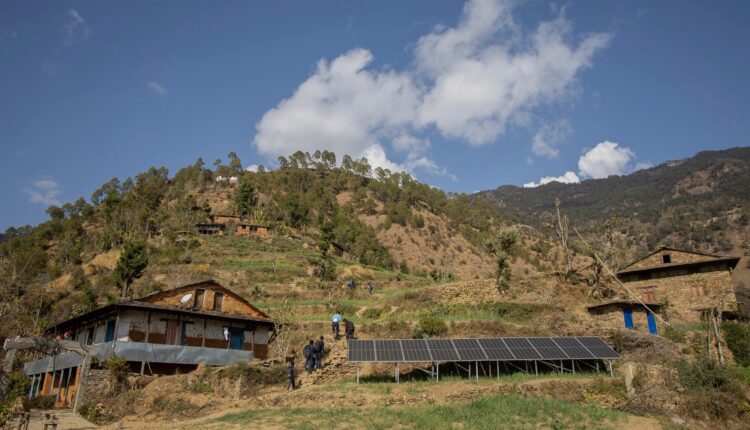Amidst the rugged terrain of Chhedegad, a municipality located in Jajarkot district, Karnali Province, lies Pajaru Health Post. Along with providing basic healthcare services, this health post houses a birthing center, and is tasked with serving the residents of this remote corner of the country.
The 6.4 magnitude earthquake that hit the province last November damaged most of the houses in Pajaru, forcing residents to seek shelter in makeshift tents during the harsh winter. This posed a significant health risk for patients, especially newborns, who are more susceptible to contracting respiratory and other ailments such as hypothermia. Furthermore, the lack of access to electricity, which is needed to power the most basic services in the health facility, created significant challenges in the delivery of health services.
Recognizing this critical need for the provision of reliable energy at the health facility, WHO, Country Office for Nepal, supported to set up a photovoltaic solar system at Pajaru Health Post. This intervention has enabled continuous operation of warmers/heaters, ensuring much-needed care to the newborns at the birthing center, and preventing deadly complications. As Pajaru is yet to be connected to the central grid, the installation of the solar system proved to be the cleanest and cost-effective energy solution.

The facility now has access to an uninterrupted electricity supply for basic lighting and continuous operation of crucial equipment, like baby warmers. Health workers say this has led to an increase in institutional delivery.
Pajaru is one of the three sites in the earthquake-affected districts of Karnali Province, where WHO has provided solar panels to electrify health facilities, an activity supported by the WHO Contingency Fund for Emergencies.

A shot of the Pajaru Health Post and the 10 Photovoltaic solar panels, installed by WHO Nepal, at Pajaru, Chedegadh Municipality in Jajarkot district, Karnali Province. Positioned strategically, these panels serve as a lifeline, ensuring uninterrupted electricity supply for basic lightning and continuous operation of warmers.
This is one of three sites in the earthquake-affected area in the province where WHO has provided support to electrify health facilities in the aftermath of the November earthquake.

Kalu Sarki, a worker at Pajaru Health Post, cleaning an infant bed inside the labor room at the health post. Electricity is crucial to power adequate lighting and medical equipment like the baby warmer.
“Since we have much-needed electricity now to run the birthing center, more mothers are delivering their babies here. This has lessened home deliveries, which ultimately contributes to reducing maternal and infant deaths during childbirth,” she says.

Inside the storage room, Prem Bahadur Mahatara, a Senior Auxiliary Health Worker, monitors the status of the batteries via a dedicated app. The app provides live status of the battery power, energy flow, storage state of charge, warnings, and other aspects of the energy system in real-time.

He regularly conducts routine checks on the solar system, ensuring uninterrupted power supply.
“As we can now keep the babies warm, there are less chances of them suffering from pneumonia. It would’ve been difficult to bring them back to health if they were diagnosed with it,” he says.

WHO personnel (left), briefs Prem on the significance of cleaning the solar panels properly. This thorough cleaning process is essential to maintain the optimum efficiency of the panels and uninterrupted power supply.

On the other side of the health post, Manisha Kumari Khadka, an Auxiliary Nurse Midwife, follows up on patients who have come to the health post. Today, she is calling Sabita Karki, 26, who had just given birth in the health post five days ago. Since the installation of the solar panel on 22 December 2023, she has already delivered five babies.
“I have delivered more than 90 babies in the last three years, and it has been extremely convenient since the installation of the solar panels. We can not only use the warmers for babies, but also the heaters which are essential to keep pregnant women warm,” she says.

Manisha makes her way to Sabita’s post-natal care (PNC) visit. Hindered by the limited road network and scarce transportation options, community members often endure hours-long hikes to reach the nearest health post.

Manisha (right) conducts a PNC checkup and provides advise on maternal and childcare.
“The solar-powered warmer played a pivotal role in ensuring crucial warmth for Sabita and her newborn during the initial days post-birth, protecting them from many diseases and complications. I am glad to see them both in healthy conditions,” Manisha says.

Sabita Sarki, with her 5-day-old child, inside her house.
“When I gave birth to my first child, there were no heaters or warmers. It was hard to keep my baby warm during nighttime. Now, it’s been much easier to keep my newborn comfortable and safe,” Sabita says.

From right: Sabita, with her husband, Hari Bahadur Sarki, and 2-year-old son, Nawayug Sarki, outside their house at Chedegadh – 9, Jajarkot.
“I feel happy we have the equipment to provide life-saving healthcare services now. I am deeply thankful to WHO for making this possible,” Manisha adds.


Comments are closed.